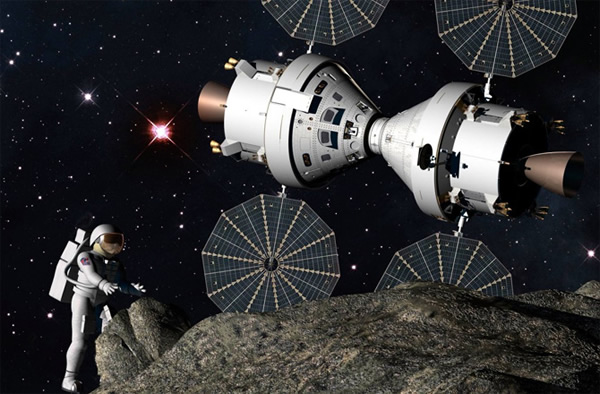Robots and Astronauts Will Defend the Earth
Robots and Astronauts Will Defend the Earth
My colleague Ian O’Neill has described one of the most unique interplanetary missions in the history of space exploration, and I’d say also one of the most important technological steps in the evolution of the human species.
The Asteroid Impact & Deflection Assessment (AIDA) mission to a binary asteroid will be the first precise test as to whether, sometime in the future, a deadly asteroid barreling toward Earth could be knocked off course by whacking it with a projectile.
In addition to hitting an asteroid, the AIDA close encounter will provide valuable information on rotation, gravity, geology, and surface properties, around the pair of asteroids gravitationally embraced in a binary orbit.
The tag-team of two spacecraft will help set the stage for an eventual human rendezvous with near-Earth asteroids (NEAs) as proposed by the Obama administration.
An asteroid visit by the first interplanetary astronaut team would allow for in-depth scientific surveys of a 4 billion year old primordial body. As with the Apollo lunar missions, astronaut EVAs on an asteroid’s surface could collect different rock samples more efficiently than robots alone. This same paradigm holds true for sending humans to Mars, the rocky dwarf planet Ceres, or and other (survivable) body in the solar system.
To ensure a successful manned mission, a robotic spacecraft would first visit the target NEA. This asteroid exploration strategy is very similar to the unmanned Ranger, Lunar Orbiter, and Surveyor missions that reconnoitered the moon before the scientifically robust Apollo landings.
In 2000, NASA’s Near Earth Asteroid Rendezvous (NEAR) Shoemaker spacecraft was the first man-made object to enter into an orbit about a NEA. NEAR circled the asteroid Eros for one year before making a soft landing.
Likewise, the precursor reconnaissance spacecraft would gingerly settle into and orbit about the potato-shaped body targeted for a human visit. The robot would test autonomous guidance and navigation for maneuvering in the NEA’s weak gravitational field, fly in formation, and perhaps even landing.
The NEA’s complex gravitational field could play havoc with an orbiting spacecraft and therefore must be mapped out by the reconnaissance probe. Because asteroids are not perfect spheres their gravity field warps space in complicated ways and makes a stable orbit problematic. What may at first seem like a safe orbit could wind up plunging a spacecraft into a head-on collision with the surface.
Once settled into orbit the probe would make three-dimensional maps of the NEA’s topography, and photograph features as small as boulders. Thousands of reconnaissance photos would reveal the shadow play on the lumpy irregular surface. Without such detailed maps an astronaut crew might be challenged interpreting their view out of the window.
The precursor craft would nail down known the asteroid’s precise spin rate. Its spectrographs and other sensors would scrutinize the asteroid’s surface chemistry and look for any potential hazards to astronauts.
A key objective for the follow-on astronaut visit would do surface experiments to study the NEA’s internal structure. This is critical to figuring out which deflection strategies are best for dealing with the marauder. Is the NEA pretty solid or is it more like a fragile flying rubble pile? This is further complicated by the fact that asteroids are collectively a mixed bag of objects shuttled in from all over the solar system.
Some asteroids may really be fragile, burned out comet nuclei. The initial astronaut visit would be a proof-of-concept for sending another crew to as asteroid deemed a high-probability collision hazard, like the asteroid Apophis. Such a mission might carry a transponder to anchor to the asteroid — reminiscent of the tracking device placed on the legendary great white shark in the 1975 film, Jaws.
Like it or not, interplanetary collisions are at the heart of the solar system’s formation and evolution. They not only tell us about the past but also predict the future history of our solar system.
Sending astronauts deep into space not only to probe our remote past billions of years, but also provide insurance for Earth’s future, is one of the biggest justifications for human interplanetary travel.
Jan 25, 2013 by Ray Villard












